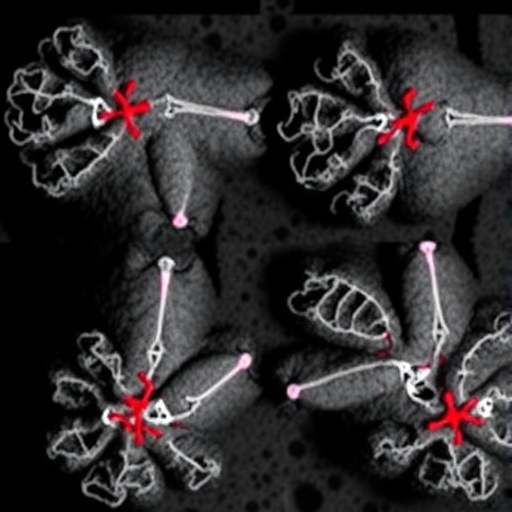CRISPR–Cas9 technology has ushered in a new era of genetic research, facilitating unprecedented advances in the understanding of gene function, particularly in the realm of viral infections. Traditionally, CRISPR-based screens have incorporated cell survival as the primary readout, creating a significant limitation. This approach often skews the results toward the earlier stages of viral infection, potentially overlooking pivotal gene interactions that occur later in the viral life cycle. In a groundbreaking effort to enhance the sensitivity and scope of these experiments, researchers have developed a novel system known as the virus-encoded CRISPR-based direct readout system (VECOS). This innovative framework positions the virus at the forefront of gene perturbation studies, thereby transforming how scientists probe the interactions between host cells and viral entities.
VECOS employs a unique strategy by engineering human cytomegalovirus (HCMV) to express single-guide RNA (sgRNA) libraries directly from its viral genome. This direct integration allows for the abundance of sgRNAs to act as a quantitative readout of how perturbations in host genes influence viral propagation. Unlike traditional CRISPR screens, which often depend on cell viability, VECOS provides a much richer and more nuanced perspective, enabling researchers to monitor sgRNA levels at different stages of the viral infection. This methodology opens the door for a more comprehensive exploration of the host–virus dynamic, illuminating interactions that were previously obscured.
The implications of VECOS are profound for the study of not just HCMV, but potentially a wide array of viruses that utilize similar mechanisms for infection. The researchers behind VECOS detail a modular protocol designed to facilitate the construction and reconstitution of complex sgRNA libraries within double-stranded DNA viruses. This is achieved using bacterial artificial chromosomes (BACs), which serve as vehicles to carry the engineered genomes into host cells for further study. With this protocol, scientists can systematically investigate various perturbation effects across multiple stages of viral infection, thereby gleaning insights into both early and late phases of viral replication and pathogenesis.
Furthermore, the multipassage screens enabled by VECOS yield rich datasets that are ripe for extensive analysis. By measuring sgRNA abundance across different infection time points, researchers are poised to derive a multidimensional understanding of how specific gene disruptions can lead to alterations in viral fitness and disease outcomes. Each passage through the viral life cycle presents unique opportunities to collect data, which contributes to a more robust dataset for computational analysis.
Running the full protocol, however, requires a considerable investment of time and expertise. The entire VECOS implementation process is estimated to take between 14 to 22 weeks, demanding a high degree of proficiency in molecular biology techniques. Moreover, researchers will need to be comfortable navigating Unix-based computing environments and programming in R, particularly for data processing and analysis stages. The necessity for these skills emphasizes the complexity of the system and the sophisticated nature of the insights that can be gleaned from it.
In terms of ethical considerations and practical applications, VECOS also poses intriguing questions. The ability to engineer viruses for research purposes necessitates rigorous ethical oversight, especially when contemplating potential biomedical applications. Exploring how host genes can modulate viral propagation not only contributes to fundamental virus biology but may have far-reaching implications for developing antiviral strategies and therapies. Understanding these interactions can also inform vaccine development efforts, thereby enhancing public health responses to viral outbreaks.
As the scientific community embraces the VECOS approach, it is imperative to address the potential challenges that may arise. A successful transition to utilizing VECOS requires alignment of multidisciplinary expertise, ensuring that teams consist of virologists, molecular biologists, bioinformaticians, and ethicists. Collaboration among these fields will foster a more comprehensive exploration of the complexities involved in host–virus interactions facilitated by VECOS.
In conclusion, the VECOS system represents a significant leap forward in the study of host–virus interactions. By engineering a viral platform capable of expressing sgRNA libraries, researchers can delve deeper into the nuances of viral propagation and host response. This approach not only enriches our understanding of fundamental biological processes but also positions scientific inquiry to tackle the pressing challenges posed by viral diseases. The impact of this technology may reverberate through various areas of research, paving the way for novel therapeutic strategies that could significantly alter our approach to viral infections moving forward.
The meticulous development of the VECOS protocol reflects a convergence of scientific creativity and technical ingenuity, laying the groundwork for future exploration in virology. As researchers continue to refine and implement these methodologies, the promise of uncovering hidden aspects of viral biology remains tantalizingly within reach. As we stand at the intersection of cutting-edge technology and pressing clinical needs, VECOS embodies the hope of gaining a deeper understanding of the interplay between viruses and their hosts, ultimately driving the future of virology research toward new frontiers.
Subject of Research: Host–Virus Interactions
Article Title: Multidimensional analysis of host–virus interactions using the virus-encoded CRISPR-based direct readout system (VECOS)
Article References:
Lilja, A., Finkel, Y., Aharon, E. et al. Multidimensional analysis of host–virus interactions using the virus-encoded CRISPR-based direct readout system (VECOS). Nat Protoc (2025). https://doi.org/10.1038/s41596-025-01242-9
Image Credits: AI Generated
DOI:
Keywords: CRISPR, VECOS, viral propagation, host-virus interactions, genome engineering, cytomegalovirus, RNA, data analysis, viral life cycle, molecular biology.
Tags: advancements in genetic researchCRISPR technology in viral researchCRISPR-based screening limitationsdirect integration of sgRNA librariesenhancing sensitivity in virology experimentsHCMV gene perturbation studieshost-virus gene interactionsnovel viral research methodologiesquantitative readout in virologyunderstanding gene function in infectionsviral infection life cycle analysisvirus-encoded CRISPR system





